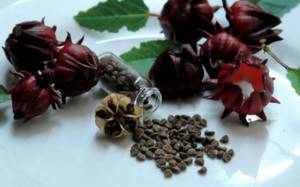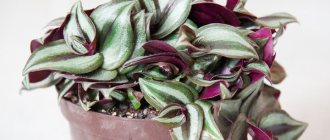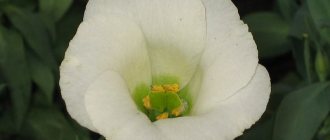Hibiscus (Chinese rose) is a tall, beautiful plant with large, bright flowers of different colors. The beautiful flower is a favorite among experienced gardeners and just amateurs. It is not whimsical in care and cultivation, and these are the main qualities of the plant’s rapid and unhindered growth.
On this topic:
Don't miss the moment when you cover your roses for the winter
Sep 5, 2020
Super-double and profusely blooming rose by Leonardo da Vinci...
Aug 24, 2020
Treatment of roses in the fall before covering for the winter -...
Aug 16, 2020
The best balcony flowers for the sunny side
Aug 14, 2020
BACK FORWARD 1 of 72
Basic information
Hibiscus is a house plant. It can be either annual or perennial. It may throw out just one flower, or maybe a large bush. It is an evergreen shrub or tree more than 2 m high. Some specimens found in nature reached 20 m in height and about 5 m in width, which shows a significant difference compared to domestic ones.
The flower has a long flowering period : the beginning occurs in early spring and the end in autumn. The hibiscus itself reaches a diameter of 15 cm, and also varies in shape - open bell or terry type.
Hibiscus, according to classification, has several types: white, lilac, scarlet, yellow and pink petals. There is also a red variety.
In addition, one bud can look unusual and combine several colors, like a painting in a picture.
Many people do not understand why Chinese rose flowers grow poorly.
The optimal conditions for the growth of hibiscus are:
- a well-lit room with sunlight;
- abundant watering in summer;
- the need to spray the sheets;
- fertilizing with organic matter.
In winter, it is necessary to keep the plant in a well-lit room, maintain moderate watering and no fertilizing.
It is necessary to feed the plant in warm seasons (spring and summer). In autumn and winter, there is no need for fertilizers, since the flower can easily do without nutrients. It is necessary to feed hibiscus once every 2 weeks.
Description
Many people probably know what hibiscus flowers look like. Their size can be called large. The main characteristic feature of the shrub is the stamens and pistil, fused and sitting in large, tender and maximally open petals, forming a rod - it is long, higher than the petals. Hibiscus flowers come in different shades.
The Chinese rose fascinates with its attractive appearance and the beauty inherent in this plant. Many people wonder if hibiscus is a flower or a garden tree? The crown is covered with emerald green leaves, and the tree trunk gives the Chinese rose a resemblance to a small tree.
Chinese rose (Hibiscus), grown in outdoor conditions, can be seen growing up to 3-4 meters tall. The maximum height of a hibiscus grown in a room is about 1.5 m. It is recommended to grow hibiscus in a tub. A powerful root system and thin, but at the same time massive branches require a lot of space.
Often the shrub is grown at home as a standard tree. It must be said that hibiscus is not only a beautiful tree with colorful flowers, it is also a wonderful food product. Healthy teas are made from dry fruits, known to everyone for their beneficial properties - “Hibiscus”, “Sudanese rose”.
The flowers of new types of geranium and terry balsam, some varieties of primrose and gardenia, Kalanchoe, terry adenium, peony and ranunculus, as well as certain varieties of tulips, are similar to hibiscus.
Proper care
Any flower shop has a large selection of fertilizers. Preference should be given to compost, which contains potassium, nitrogen and phosphorus. For best results, fertilizers should be mixed in water at room temperature.
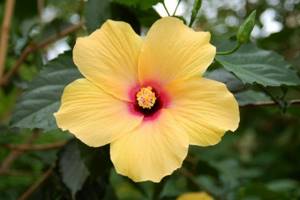
To enhance growth, it is necessary to fertilize the root system, but do not allow substances that contain nitrogen to come into contact with the flowers of the plant - this leads to irritation. Excessive feeding or underfeeding can lead to death of the rose: the leaves of the plant will gradually turn yellow and fall off.
The plant must be replanted and its further propagation promoted. Basically, transplantation occurs in early spring in prepared soil. For the best effect, hibiscus should be planted in soil rich in fertilizers.
The recipe for the nutritional mixture is simple:
- turf soil;
- deciduous soil;
- humus soil;
- sand;
- peat soil;
- bone flour.
Before planting a Chinese rose flower in a pot, you need to make a layer of drainage in the container. After replanting, the plant should be trimmed in the shape of a crown. It is not recommended to replant mature hibiscus; it only needs to replace the top soil.
The rose propagates in July-August by cuttings.
The cuttings quickly produce roots and grow. They must be treated with a special substance (growth stimulator) and planted in prepared soil. Cuttings should be provided with a comfortable temperature (22−25 °C).
Origin and legends
Hibiscus came to Russia straight from China. In addition to this country, it is common in East Asia. In Malaysia, the rose is considered an ethnic symbol, and the plant's image is minted on local coins. There are many legends about the appearance of this flower.
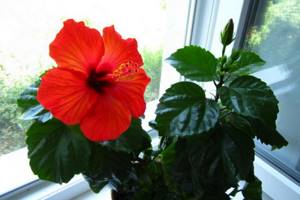
A legend from East Asia speaks of a wanderer. The exhausted man lost his way. Exhausted by hunger and thirst, he sat down in the shade of the trees and asked the gods for food. And then bright red flowers fell on him. The traveler decided to try this plant and brewed aromatic tea. With every sip, strength and energy filled his body. Leaving the forest, the traveler took these flowers with him and distributed them to everyone he met, telling about the amazing tea properties of the flower.
This legend is not only about the hibiscus itself, but also about the world-famous hibiscus bush tea .
In addition, all parts of hibiscus are used in medicine; leaves and shoots are used as food. Flowers are used in the preparation of dyes: black for hair, purple for industry.
Flower of death
The rose was nicknamed a frightening nickname - the poisonous flower of death. A lot of bad things are said about the plant. Negative opinions are mainly in European countries, but in Asia this flower is loved and revered.
A large number of superstitions are associated with the flowering of roses. According to superstitions, if a Chinese rose blooms prematurely, it is a harbinger of death in the family. Most people believe that the fading of flowers is a good sign, but this is a prejudice.
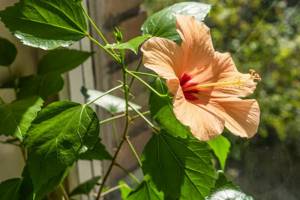
Superstitions say that wilting is associated with the onset of a serious illness in a family member. Most often, the disease is asymptomatic.
If a person sees that the hibiscus is dying , then, according to superstitions, he should undergo a medical examination himself. There is also a judgment that a withering Chinese rose is deprived of satisfactory nutrition. In order not to weaken completely, it draws energy from all family members, causing tiredness, ailments, and headaches.
This superstition has another explanation - if a rose fades, it means that the flower takes all the negative energy in the house for itself, in this way it protects the owners from bad energy.
Often the flowering of a rose is associated with family disagreements, they say, the plant sows negativity, and it is the flower that is the culprit of irritation and aggression. In addition, a blooming rose attracts illness and bad luck. The maximum level of bad energy emission is associated with flowering time.
The bloom of hibiscus in the house is associated not only with death, but also with good future events. For unmarried girls, this predicts an early meeting with their betrothed, but if a rose blooms in the house of a married woman, then this predicts family disagreements and quarrels, which can be the initiators of divorce. Other superstitions say that a blooming rose is a symbol of new feelings and additions to the family.
Practical recommendations
Many people are afraid to keep a rose in their apartment, because it is called the “Flower of Death.” It is known that a person can influence the environment. If the owner and the flower are sick, then this is primarily associated with the energy of the “Flower of Death”, but not vice versa. It is a proven fact that if there is a good atmosphere in the family, then the plants in this house will bloom and not fade.
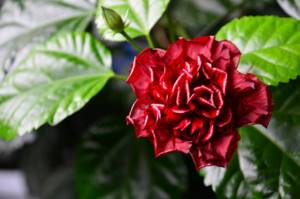
Interesting information: hibiscus is often blamed for illness and quarrels. Experts assure that flowers are capable of absorbing all the bad energy onto themselves, but this does not benefit them. In addition, it is believed that the Chinese rose helps to gain willpower and eliminates laziness, and increases creativity. Hibiscus also helps build close relationships between husband and wife, strengthening their marriage. Often the flower is placed near the bed.
There are a large number of negative signs about indoor roses, but most of its owners live happily and without illness, enjoy flowering and are not aware of superstitions.
There is no need to pay attention to negative interpretations, because thoughts tend to become reality. But this does not mean complete safety. For example, there is an allergy to hibiscus pollen; if a person is susceptible to this disease, then it is worth giving up the plant.
What to do when the castings of a Chinese rose turn yellow
If yellow spots begin to appear on the leaves of the hibiscus, this means that the plant has become infected. Over time, all the greenery will begin to spin and dry out, as a result it will fall off and the flower will die.
If you carefully examine a Chinese rose, you can see a mite. This parasite is very dangerous for the plant, so its neutralization is required. How to do it? It is necessary to spray the hibiscus leaves with pesticides, for example, “Aktelik” or “Fitoferm”. These substances are used to treat indoor flowers. To completely defeat the parasite (mite), it is worth disinfecting the plant at least three times. This procedure must be done once a week.
Experienced flower growers know that the best fight against flower diseases is prevention. To do this, it is worth treating Chinese roses with disinfectants once a month.
Growing in the garden
Hibiscus arrived in Russia from Asia; the climate is not very suitable for the flower. With the help of breeders, a special variety of Chinese rose was developed that can grow outdoors at such latitudes. This variety exceeds 3 m in height and can withstand very severe frosts. Therefore, its cultivation is recommended by botanists.
In order for a flower to survive the cold outside, it needs to be helped by artificial means. Winter in Russia is characterized by a drop in temperature below 30 degrees, so the flower needs to be well covered or replanted and brought into the house.
If you want to have this plant in your garden, then you need to know some nuances:
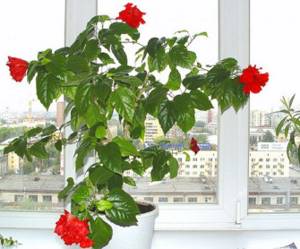
- Before planting, you need to find a suitable place where the plant will be protected from sunlight.
- The rose should be planted in loose and nutritious soil, not forgetting to water it as the soil dries out.
You can grow hibiscus by planting seeds (fruits) or cuttings. Which method to choose depends on the owner. Seeds must be sown in mid-winter. Damaged bushes must be sprayed with water. Roses should be planted in the ground after frost.
If the owner decides to cut a rose, then all the leaves must be removed from the shoot and placed in water. After long roots appear, the plant must be planted in a pot with nutrients; as soon as the rose gets stronger, it can be planted in the ground.
A small rose must be carefully insulated in winter, because a young plant is more susceptible to frost.
What do the seeds look like?
After flowering, hibiscus forms round pods with seeds. When ripe, they dry out and begin to open, throwing out seeds. They are difficult to confuse with the seeds of other indoor or garden ornamental crops. They look quite massive, although the seed size usually does not exceed 3 mm. Normally ripened seeds are dark brown, almost black in color. The shape of the seed, close to the shape of a circle, is slightly pointed in the lower part, where the embryo is located, so some gardeners compare it with the symbolic figure of a heart.
The main difficulty is not to miss the moment of opening of the fruit. Collecting spilled seeds is not at all easy. The color of the fruit will indicate the ripening of the fruit. The pods gradually lose their green color, becoming brown. Some gardeners suggest covering the plant with open paper bags at this time, which will catch the falling seeds. In this case, ripening will be natural, which will allow you to obtain more viable seeds.
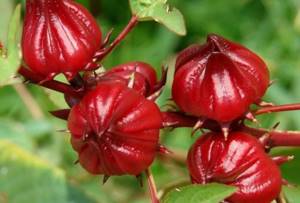
It is also possible to collect fruit pods with their further drying and artificial opening with a knife. The seeds do not ripen at the same time, so their color will be different. In this case, there is a danger that some of the seeds will be unripe. However, this method completely eliminates accidental losses; the yield of planting material ultimately turns out to be almost the same as in the first case. The collected seeds have to be sorted and sorted by hand. This is necessary to exclude unripe or damaged specimens. Undrained seeds can cause mold and rot to spread.
Beginning flower growers often save all the seeds they receive, cherishing the first positive results of breeding Chinese roses. However, practice shows that pity in this case is inappropriate, since low-quality seed material can cause serious disappointment, since most often it does not live up to expectations. And if the plant miraculously sprouts, growing a weakened sprout will be very difficult.
